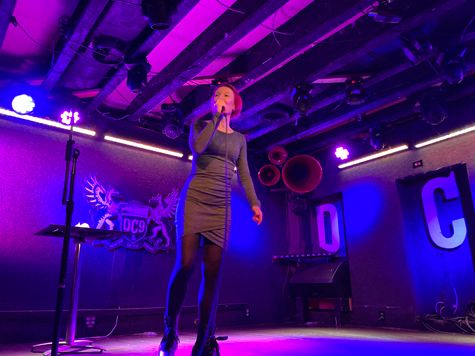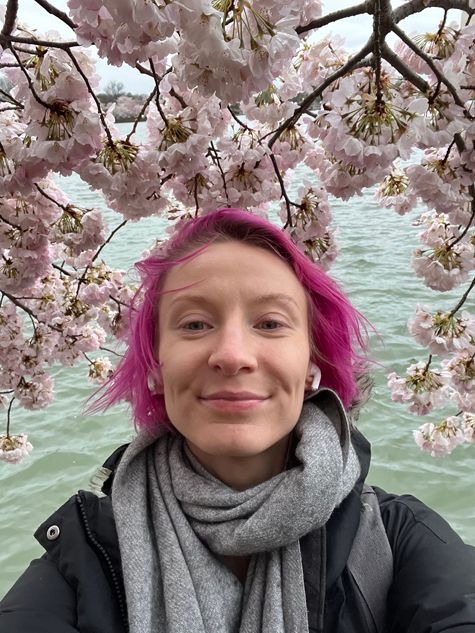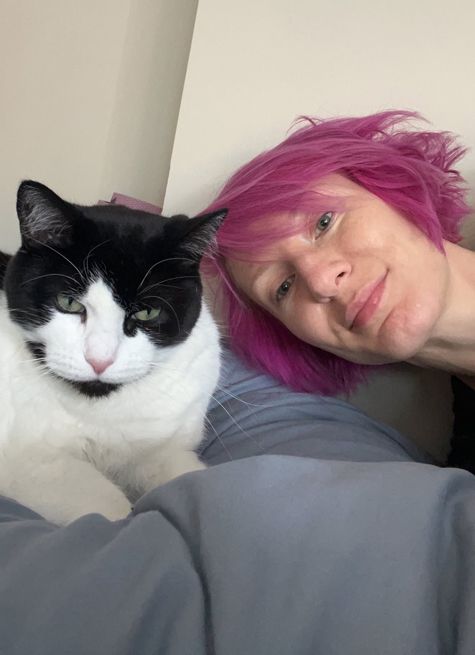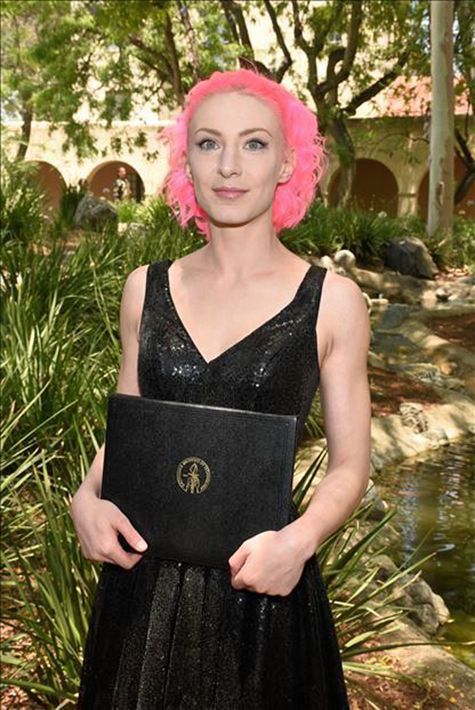Early Career Scientist Spotlight
Dr. Sarah Gossan (she/her/hers)
Computational Astrophysicist
Gravitational Astrophysics Laboratory (663)
What inspired you to pursue a career in Astrophysics?
Honestly? Legally Blonde. For as long as I can remember, I’ve been interested in science, space, and how the universe works, but that’s true for a lot of things. From hairstylist to pastry chef, from fashion designer to astrophysicist, there have been two constants in my career ambitions: (1) learning how things work and (2) sharing those skills with the world.
My parents have always shown boundless support for whatever I’ve wanted to accomplish, but the first time I thought astrophysics was something that *I* might want to do for a career, was watching Elle Woods get her law degree. Growing up, I had the misconception that to become a scientist, one had to shed their individuality for some white coat and serious façade. It may seem silly, but watching Legally Blonde for the first time made me realise that one could pursue their dreams while still holding strong to their identity, and that was somewhat of a revelation for me.
With that being said, I applied to university to study Astrophysics, but I didn’t know it would be my eventual career goal. I chose it over my other love at the time (fashion design) because I figured an astrophysics degree would give me better economic prospects on the job market. As the first person in my immediate family to go to university, I was very conscious of making the most of that opportunity.
During my second year of university, my first academic mentor (Prof. Carole Tucker), encouraged me to apply for a summer research internship with the gravitational waves group at Cardiff University. I was luckily chosen for the position, and that summer was transformative. It was there that I first met my undergraduate research advisor (Prof. Bangalore Sathyaprakash), who encouraged me to apply to graduate school and pursue a career in research.
I’m endlessly grateful to Profs Sathyaprakash and Tucker for their support, guidance, and encouragement during my formative academic years, without whom I very likely would not be where I am today. Since that fateful summer, I’ve never looked back!

Credit: Ashley Robbins
What is your research focus?
Broadly speaking, I like to say I study giant space explosions, and the immortal stars they leave behind.
My research is focused on better understanding the central engines driving core-collapse supernovae, long gamma-ray bursts, and other high-energy transients involving compact objects. While we’ve seen the electromagnetic signatures of many of these, the photons we observe from these systems typically originate from the outer regions — far from the central engine — meaning that we receive only second-hand information on what’s driving the explosions themselves. Gravitational waves and neutrinos, however, come straight from the heart of these beasts. As such, they provide us a unique opportunity to directly probe the dynamics of these bursts, and the compact objects formed therein.
Using a combination of numerical simulations, semi-analytic modelling, and data analysis techniques, I first work to predict the signals we’d expect from these sources, then develop novel algorithms to improve our prospects for both observing them and inferring key source properties such as mass, spin, and accretion rate.
The questions I seek to answer are: “How do collapsing massive stars explode?”, and “What are the properties of neutron stars and black holes born this way?”
What is one of your favorite moments in your career so far?
I’m going to cheat here somewhat and mention three.
First of all, while I was in graduate school, I directed the social media campaign for the announcement of the first direct detection of gravitational waves on behalf of the LIGO Scientific Collaboration. Travelling to the National Press Club in Washington DC and live-tweeting the NSF Press Conference while the world was watching was truly a once-in-a-lifetime experience that I’ll never forget. Later that day, President Obama retweeted the LIGO account and congratulated the collaboration on the momentous detection while I was celebrating with colleagues — the perfect end to a very special day.
Secondly, when I graduated with my PhD. More often than not, regrettably, graduate school can prove somewhat of a baptism by fire for its attendees. My experience there was incredibly turbulent; from academic challenges, sure, but predominantly from sexual harassment and bullying, not to mention the marked lack of support from colleagues there. When I stood on that stage and was hooded, it was a testament not only to my academic achievement, but also to my tenacity and determination.
Last but certainly not least, when I was offered a tenure-track position at Hofstra University, where I’ll be starting as an Assistant Professor of Physics and Astronomy in the fall. As an astrophysicist, I find my research super interesting and incomparably fun, but the most rewarding part of this job for me is mentoring students and training up the next generation of scientists. To have to opportunity to do that, and at a university renowned for prioritising student experience and welfare alongside research excellence, is a dream come true for me. I’m unspeakably humbled by this opportunity, and am so, so excited for what the future holds.

Credit: Sarah Gossan
What advice would you give your younger self?
Believe in yourself. You worked incredibly hard to get where you are, and you belong here. You will come across many people seeking to invalidate your accomplishments and your existence in academia; know that it says way more about them (and their own insecurities) than it ever could about you.
You are completely worthy, even without coming from a family of academics or being trained for this since birth. Be proud of where you came from and acknowledge that the obstacles you’ve overcome to get here have made you that much stronger.
Do not be afraid to stand up for yourself. It is not selfish to advocate for your own interests when others are ignoring your humanity. Your mental health is not a bargaining chip to be traded for academic success.
You are a scientist; therefore you are what a scientist looks like.
What do you like to do in your free time?
As I spend a lot of time at work tackling analytic or computational problems, I very much enjoy pursuing creative endeavours elsewhere. That can take a number of forms: designing and making clothes, crafting, cross-stitch, making mixed-media art pieces, baking, watching live music, and writing poetry. I’m also somewhat of a public transport enthusiast, and love exploring the places I’ve lived via bus, metro, train, tram, or even just on foot. To relax, I love to Netflix and chill with my best friend — my cat, Indica — to catch up on true crime and murder mysteries!

Credit: Sarah Gossan
What is a fun fact about you?
I’m going to cheat again on this one and give another three answers.
First, I adore tattoos and currently have a total of eleven. My favourite one so far is a half-sleeve portrait of Hedy Lamarr, who is one of my heroes.
Next, I’m an avid fan of mid-00s emo, and recently fulfilled a major teenage aspiration by going to see My Chemical Romance in New York City. It was never a phase, Mum!
Finally, I’ve had bright pink hair for the last five and a half years, and I hope to keep it that way for the foreseeable future. I first dyed it on a whim during a very tough time in graduate school when I could no longer see any sparkle in the world. On first seeing the pink hair, my heart felt so full, and I had the strength to keep pushing forward. While I’m thankfully in a much better place now, I never want to forget the importance of creating my own sparkle in a world so often bereft of it, and so keep my hair this way as a personal reminder of that.
What are your future research interests and goals?
My most important goal is building up a thriving research group at Hofstra University, fostering an environment where students are empowered to pursue and accomplish their dreams.
Scientifically, there is much to be done. While we’ve observed gravitational waves from around one hundred compact binaries so far, we’ve yet to see any non-binary sources. The scientific landscape for probing stochastic burst sources, particularly using ground-based gravitational wave detectors, is woefully under-explored. Over the next decade, I aim to lay out our prospects for multi-messenger observations of stochastic bursts, millisecond pulsars, and accreting compact objects within our very own cosmic backyard, the Milky Way. There are many aspects of this work perfectly suited for students, whatever their interests, including development of data analysis algorithms, analytic modelling of astrophysical sources, and experience with high-performance computing facilities.
On the more creative side, I hope to produce a couture capsule collection of evening wear pieces inspired by supernovae, their remnants, and impact upon known life in our universe. Science and art are far more intricately linked than commonly portrayed in the media, and I strongly believe that science communication through a variety of art forms (be that fashion, music, media installations, or otherwise) is crucial to engendering passion for science in the public domain.
Biography
Home Town:
Bristol, UK
Undergraduate Degree:
MPhys Astrophysics, Cardiff University (Cardiff UK)
Post-graduate Degrees:
Ph.D. Physics, California Institute of Technology, (Pasadena, California)

